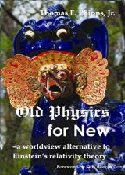Old Physics for New: a worldview alternative to Einstein’s relativity theory
Old Physics for New: a worldview alternative
to Einstein’s relativity theory
Thomas E. Phipps Jr.
Publisher: C. Roy Keys Inc.; First Edition edition (December 1, 2006) – amazon
From the author of Heretical Verities, a study more sharply focused on the sins of relativity theory. Where physicists see transcendent beauty, Phipps finds
institutionalized ugliness. Where field theorists have eyes only for the glitter of Maxwell and Einstein, he commends the subtler attractions of the Cinderella of modern electromagnetic theory, Heinrich Hertz. – From the Foreword by Dr. David F. Roscoe
These few words of introduction are primarily directed at those readers who are not familiar either with Tom Phipps‘ singular style of scientific prose or, more importantly, with his rigorously applied view that, when theorizing about the world around us, we must pay absolute attention to the practicalities of the measurement processes by which the quantities involved in this theorizing are measured. Let me talk about the Phippsian prose style first: the common experience upon reading a scientific text is to be confronted by a finished article, that is, by a text from which all sense of intellectual journeying has been exorcised, cleansed, deleted. The experience may be necessary but it is rarely exciting and never invigorating, it becomes merely a job that must be done, a dusty dry road along which weary feet must be dragged. But Phipps refutes this puritanical model; he is renaissance man, the man who glories in the splendour of the written word and its capacity to illuminate the obscure, and to decorate the plain. And so the experience of reading Phippsian scientific prose is not unlike that of reading a good detective novel, the dim detective, the obvious clues overlooked, the false trail followed, the unsolved crime written up as solved so that the bureaucrat can sleep his dreamless sleep and, finally, Sherlock Holmes with his pipe and Dr. Watson.
Book Review, I. J. Good, Physics Essays, V21, N4, pp. 313-314.
Biography
Thomas E. Phipps, Jr., born in Champaign, Illinois. Educated at Harvard, AB, 1944; Ph.D., 1950 in Nuclear Physics. Worked during World War II in P. M. Morse’s Operations Research Group in the Navy Department, subsequently returning to Harvard to do an experimental thesis on Molecular Beam NMR under Norman Ramsey. His career included a total of twelve years in the Pentagon, ten in systems analysis for the Navy and two in research management for the Department of Defense, as well as similar employments at Navy laboratories in California and Maryland. In 1980 he retired to form a small private physics laboratory in collaboration with his father, an emeritus professor of physical chemistry at the University of Illinois, in which they performed experiments in electromagnetism. In 1986 he wrote a book, Heretical Verities: Mathematical Themes in Physical Description. After his father’s death in 1990, he has continued both experimental and theoretical investigations into basic physics
—————————————————————
Siehe auch vom Autor in diesem Blog: Back to Newtonian Time?
.
- 25. Dezember 2012
- Artikel
